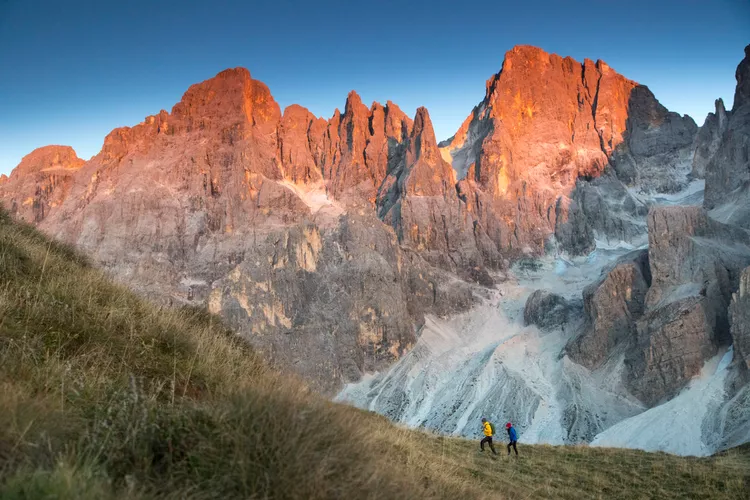As the coronavirus pandemic continues to shape the travel landscape, it’s difficult to envision a time when travelers will eagerly crowd into spaces like the Vatican Museums, squeeze into St. Mark’s Basilica, or sunbathe shoulder to shoulder on an Amalfi Coast beach.
So, what’s a vacation in Italy without crowded attractions, bustling piazzas, and closely configured restaurant tables? It transforms into an active adventure waiting to unfold.
While Italy is renowned for its cities, museums, and landmarks, it also boasts open spaces — including the rolling fields of Tuscany, the Apennine and Dolomite mountain ranges, and the expansive rugged terrains in the south. With an abundance of space and serenity, there is plenty of fresh air to breathe and room for safety and exclusivity. Therefore, adventure travel in Italy offers active vacationers a chance to connect with the natural side of the country, stay in rural accommodations, and indulge in exceptional local cuisine. Thus, instead of following the well-trodden Rome-Florence-Venice circuit, consider these less-traveled journeys into Italy’s majestic outdoors.
Walk the Via Francigena Path
Italy’s answer to Spain’s Camino de Santiago, the Via Francigena route begins in Canterbury, England, and stretches for 1,700 kilometers (1,056 miles) through France, Switzerland, and Italy, culminating in Rome. Specifically, 400 glorious kilometers (248 miles) run north to south through Tuscany. Therefore, walking any segment of this path allows for an up-close experience of the land’s earthy beauty. The classic portion from the walled city of Lucca to medieval Siena encompasses 132 kilometers (82 miles), typically spread over seven nights. Visitors can stay in historic hotels, simple pilgrim hostels, or cozy agriturismi (farm stays) amidst the iconic Tuscan landscape. Expect picturesque cypress trees, rows of undulating grapevines, and local delicacies like Super Tuscans, salami, and pasta with porcini mushrooms. Camino Ways can assist in planning a weeklong hiking or biking trip, offering various lodging and meal transport options.
Follow the Shepherds in Abruzzo
For centuries, shepherds worldwide have migrated their flocks seasonally, a practice known as transhumance, which UNESCO recognizes as part of its Intangible Cultural Heritage of Humanity. Although industrial farming has largely eradicated this practice, it continues in Abruzzo, the mountainous region east of Rome. In June and July, environmentally conscious trekkers can join shepherds and their flocks for immersive experiences, walking along rushing rivers, through crumbling stone villages, and scaling steep mountain trails to the herds’ summer pastures. These bucolic adventures include breaks for snacks of bread and cheese paired with someone’s homemade wine or fruit tart, hearty meals, and the option to sleep under the stars or at a simple inn. Notably, Nunzio Marcelli, a renowned figure among transhumanza advocates, organizes four-day, three-night trips through the La Porta dei Parchi agricultural cooperative.
Italy’s New Hiking Trail Will Connect All 25 National Parks
Hike to High-altitude, Rustic Digs in Trentino
In the craggy Dolomite Mountains, a series of rustic huts await hikers with simple yet cozy overnight accommodations and hearty meals. Known as rifugi (the plural form of rifugio), these high-altitude lodges—some rising 2,500 meters (8,200 feet) above sea level—have offered respite to weary mountaineers for over a century. Trentino alone hosts more than 140 rifugi, typically open from June through September. While some lodges are accessible only on foot, others are reachable by roads or cable cars. However, all provide a warm welcome after a strenuous day of trekking. Options for accommodations range from cozy private rooms to simple dormitories. Each rifugio features breathtaking views and a nighttime celestial display that entirely eclipses flat screens and Wi-Fi. A spectacular experience awaits. Visit Trentino offers comprehensive details on staying at rifugi, which require advance planning, including hiking distances and difficulty levels.
Journey to Mount Etna on Horseback
Throughout history, Greeks, Romans, Byzantines, and Normans have roamed through the seaside town of Cefalù, Sicily, which serves as the starting point for an exhilarating horseback trek to Mount Etna—approximately 130 kilometers (81 miles) away. En route, riders can expect to spend up to eight hours a day in the saddle, traversing ancient roads through enchanting beech forests, beside tranquil mountain lakes, and past historic castles and villages. The Tyrrhenian Sea—and the Aeolian Islands—come into view intermittently until Mount Etna, Italy’s largest active volcano, takes center stage. Ascend through the magnificent orchards, vineyards, and olive groves lining Mount Etna to experience a truly unique landscape. Guests will rest in rural farmhouses and savor fresh, farm-to-table meals alongside the region’s wine, cultivated from the rich volcanic soils. Unicorn Trails organizes eight-day, seven-night itineraries that include meals, overnights, and transfers.





